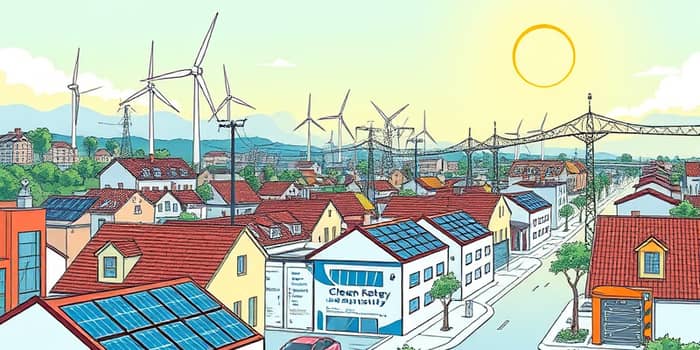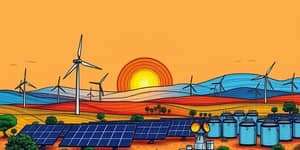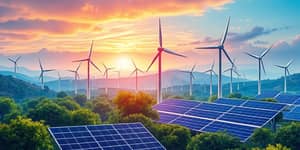In the wake of accelerating climate targets and geopolitical shifts, clean energy startups are commanding unprecedented interest from investors worldwide. From solar innovators to carbon capture pioneers, early-stage ventures are tapping into a historic surge of capital, reshaping how we generate, store, and manage power.
This article unpacks the key data driving this momentum: record broken investment figures, evolving venture capital landscapes, leading technological breakthroughs, and the policy frameworks that are de-risking large-scale deployment. We dive into the challenges ahead and explore success stories lighting the path forward.
Unprecedented Global Investment Surge
The global energy sector is experiencing an investment renaissance. In 2025, total capital allocated to energy projects worldwide is expected to hit a staggering $3.3 trillion. Remarkably, twice as much is going to clean energy initiatives compared to fossil fuels, signaling a decisive pivot towards sustainability. Solar power alone has emerged as the single largest category of investment within global energy spending, even surpassing traditional oil production in funding prominence.
Clean energy sub-sectors have attracted diverse allocations: renewables, nuclear, grids, storage, low-emissions fuels, efficiency, and electrification. Estimates suggest that renewables will capture over $1.3 trillion, storage around $300 billion, and grid modernization more than $220 billion by 2025—underscoring the multi-billion-dollar potential across every segment.
To contextualize this growth, consider the table below comparing overall energy investment in 2023 with projected figures for 2025:
These figures illustrate not only the scale but also the accelerating pace of capital inflows into renewables, storage, and electrification. Governments and private investors alike are aligning to meet ambitious climate goals, driving unprecedented financial commitments across every continent.
Venture Capital Trends and Regional Dynamics
Over the past decade, investors have poured more than $230 billion into energy startups, with funding surging by 570% between 2015 and 2022. Clean energy startups achieved a record $12.3 billion in venture funding in 2022, only inching back to $11.6 billion in 2023—a modest 6% decline that contrasts sharply with a 38% drop in overall VC investing. This resilience underscores a global push for decarbonization that transcends economic cycles and market volatility.
Despite this overall stability, the nature of funding has shifted. Average rounds shrank by 36% in 2023, falling to $34 million per deal as investors adopt a more cautious stance amidst high interest rates and geopolitical uncertainty. Meanwhile, AI startups captured nearly $50 billion in venture capital, intensifying competition for finite resources. Regional trends reveal a stark divergence: North America and Europe experienced 21% and 29% funding declines, respectively, while Asia-Pacific—led by China—doubled its clean energy VC intake in 2023.
Seed and Series A deals have become more common entry points, reflecting investor focus on technological due diligence and milestone-based funding tranches. Corporate backers have remained active, injecting capital through strategic partnerships and in-house venture funds, reaffirming higher corporate engagement in energy innovation.
Corporate R&D spending in the energy sector also remains robust, totaling $160 billion in 2023. Automotive firms lead the charge, with 13 of the top 20 corporate spenders hailing from the auto industry. Chinese energy R&D budgets surged from $18 billion in 2015 to over $62 billion in 2023, emphasizing the country’s commitment to domestic clean energy leadership.
Main Technological Focus Areas
Startups are exploring a diverse range of technologies to decarbonize power grids, transportation, and industry. The most heavily funded areas include:
- Renewable Energy Generation: Advanced solar PV, offshore wind, and geothermal systems
- Battery Technologies and Storage Solutions: Solid-state designs, flow batteries, and grid-scale storage deployments
- Smart Grid and Infrastructure Upgrades: IoT-enabled networks, microgrid frameworks, and AI-powered demand response
- Energy Efficiency and Building Electrification: Heat pumps, smart HVAC controls, and advanced insulation materials
- Clean Transportation and Mobility: Next-generation electric vehicles, hydrogen fuel cell platforms, and charging infrastructure
- Carbon Management: Direct air capture, industrial heat pumps, and carbon utilization pathways
Investors are particularly drawn to solutions with rapid cost declines and clear path to profitability, such as perovskite solar cells and modular electrolyzer units. The combination of policy incentives and technological breakthroughs has created record $3.3 trillion in 2025 pipelines for commercialization pilots and first-of-a-kind deployments.
Key Drivers Behind the Funding Boom
Multiple catalysts are fueling this unprecedented flow of capital into clean energy ventures:
- Energy Security: Geopolitical tensions and supply chain disruptions have underscored the need for sovereign and reliable power sources
- Climate Policy and Regulation: Net-zero commitments, carbon pricing, and renewable standards incentivize low-carbon solutions
- Technological Innovation: Advances in materials science, digital optimization, and modular manufacturing drive down costs
- Market Demand: Corporate sustainability targets and consumer preferences for green products sustain high uptake
- Legislative Support: Policies such as the U.S. Inflation Reduction Act unlock subsidies, tax incentives, and grant programs
Public and private stakeholders are working in tandem to align capital deployment with national emissions goals, creating a reinforcing cycle of investment and policy momentum. Initiatives like international climate finance facilities are channeling billions toward emerging markets, broadening the overall funding base.
U.S. Policy and Legislative Influence
In the United States, federal initiatives have reshaped the investment landscape. Over the last four quarters, American clean energy sectors attracted $277 billion invested in clean energy, a 13% increase over the previous year. The Inflation Reduction Act stands at the forefront, offering a suite of incentives including up to 30% investment tax credits for solar and wind, the 45Q carbon capture credit of up to $85 per metric ton of CO₂ sequestered, advanced energy manufacturing grants and loans for domestic facility build-out, and clean hydrogen tax credits up to $3 per kilogram produced.
These measures are de-risking large-scale investments and partnerships by providing non-dilutive capital, facilitating public-private collaborations, and enabling startups to secure anchor customers in utilities and industrial offtakers.
Challenges and Risks Ahead
While optimism looms large, several headwinds could temper the funding trajectory for clean energy startups:
- Economic Uncertainty: Elevated interest rates and inflation could constrain investor appetite for capital-intensive projects
- Regulatory Hurdles: Lengthy permitting, interconnection delays, and evolving safety standards slow time-to-market
- Capital Competition: AI and biotech sectors continue to command significant shares of VC resources
- Policy Uncertainty: Upcoming elections and potential shifts in climate agendas introduce planning risks
- Supply Chain Constraints: Semiconductor shortages and reliance on rare-earth materials pose bottlenecks
Startups that demonstrate robust project economics, clear revenue models, and strong strategic alliances will be better positioned to weather these uncertainties. Building flexible supply chains and securing long-term offtake agreements can further mitigate these risks.
Emerging Success Stories and the Road Ahead
Despite the challenges, several clean energy pioneers are forging new paths. Companies specializing in solar recycling have raised growth rounds exceeding $150 million, while startups delivering second-life batteries for grid balancing have secured major partnerships with utilities. In the hydrogen domain, a handful of firms have achieved near-commercial-scale electrolyzer operations, attracting both venture capital and corporate backing.
Looking toward 2026, the market will be closely watching the first commercial deployment of solid-state batteries in electric vehicles, the expansion of virtual power plants aggregating distributed energy resources, the scale-up of regional green hydrogen production hubs supported by cross-border pipelines, and early-stage carbon capture projects reaching operational milestones.
For entrepreneurs, success hinges on marrying technological breakthroughs with real-world applications that deliver measurable emissions reductions and economic benefits. Investors, in turn, will demand rigorous data on cost trajectories, policy alignment, and environmental impact.
As global capital continues to chase transformative energy innovations, startups that can combine technical excellence with strategic partnerships will lead the next wave of decarbonization, forging a cleaner, more resilient energy future.
References
- https://www.iea.org/news/global-energy-investment-set-to-rise-to-3-3-trillion-in-2025-amid-economic-uncertainty-and-energy-security-concerns
- https://e2.org/releases/april-2025-clean-economy-works/
- https://www.euci.com/clean-energy-startup-investments-totaling-230-billion-over-the-last-decade-are-slowing/
- https://www.oliverwyman.com/our-expertise/insights/2024/jul/global-venture-capital-trends-in-clean-energy.html
- https://www.revli.com/energy-funded-startups/
- https://www.iigcc.org/insights/world-energy-investment-2025-highlights-electricity-demand-and-energy-security-new-drivers
- https://eere-exchange.energy.gov
- https://www.cleaninvestmentmonitor.org










